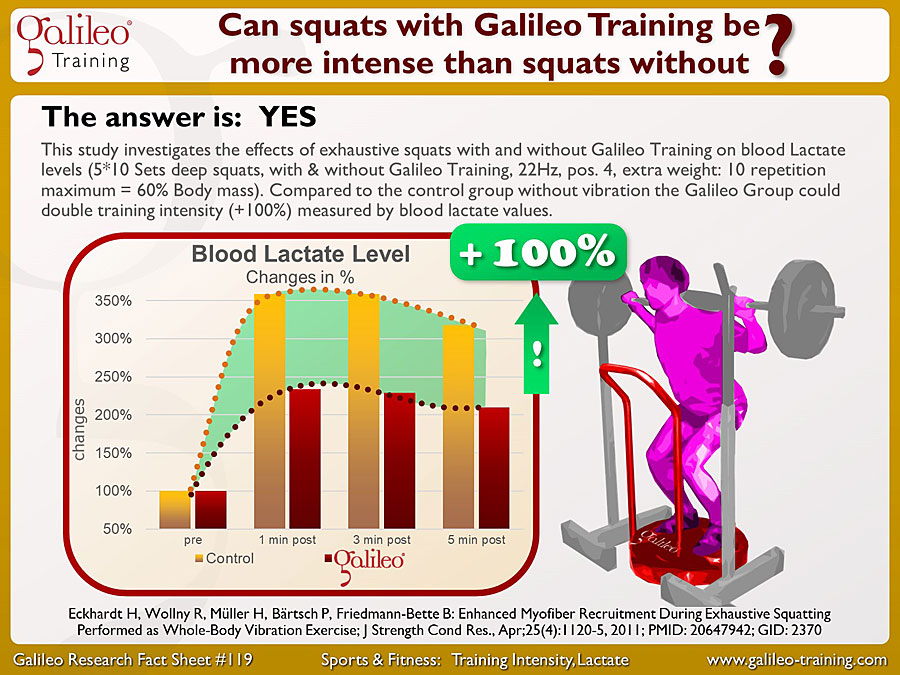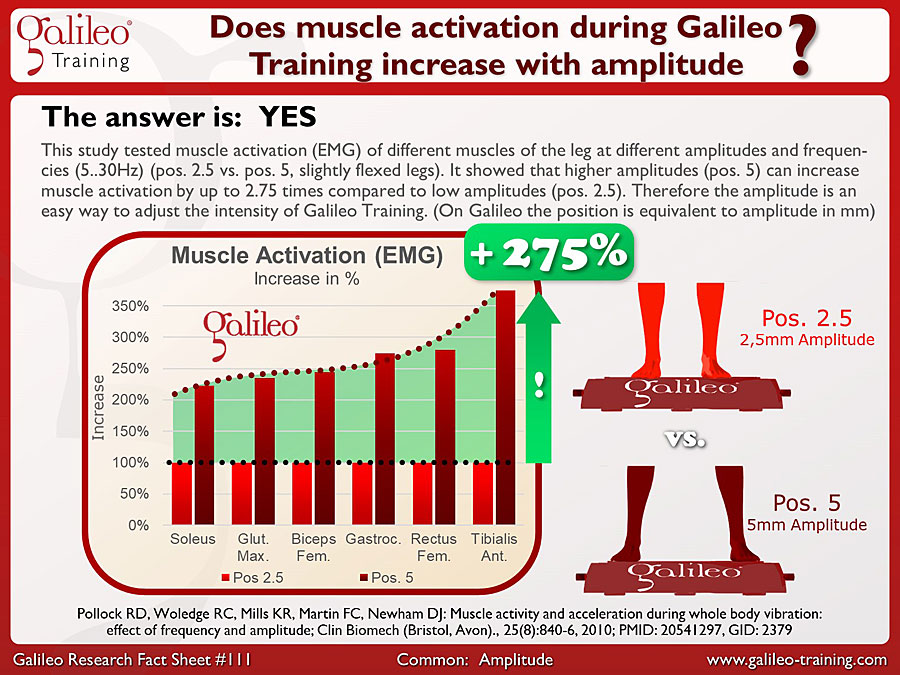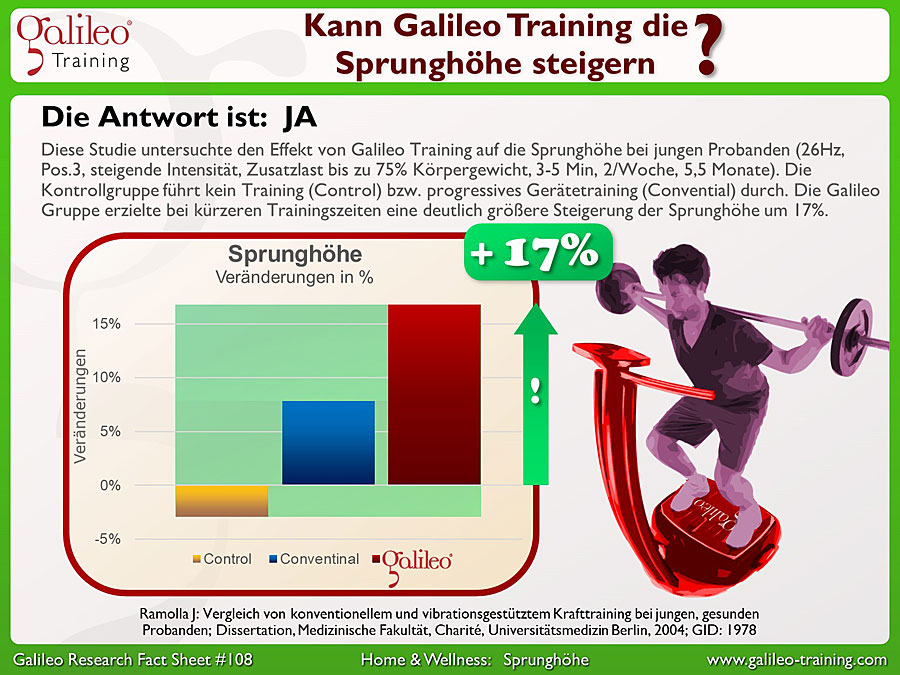This study investigates the effects of exhaustive squats with and without Galileo Training on muscle activation (EMG) (5*10 Sets deep squats, with & without Galileo Training, 22Hz, pos. 4, extra weight: 10RM = 60% Body mass). Compared to the control group without vibration the Galileo Group could almost triple muscle activation (+196%) during eight repetitions...
Galileo Research Facts No. 121: Can Galileo Training increase muscle function and balance at the same time?
This study investigated the effects of Galileo Training on muscle function an balance in women age 52 to 60 (15-25Hz, 6 exercises, extra loads up to 30% body weight, pos.1-3, 35 min., 3/week, 12 weeks). The conventional group received identical exercises without vibration. The Galileo group showed identical results on muscle function but significantly higher results on all tested balance test with improvements o up to 61%...
Galileo Research Facts No. 119: Can squats with Galileo Training be more intense than squats without?
This study investigates the effects of exhaustive squats with and without Galileo Training on blood Lactate levels (5*10 Sets deep squats, with & without Galileo Training, 22Hz, pos. 4, extra weight: 10 repetition maximum = 60% Body mass). Compared to the control group without vibration the Galileo Group could double training intensity (+100%) measured by blood lactate values...
Galileo Research Facts No. 117: Can posture variation during Galileo Training decrease vibration transmission to the head?
This study documented the influence of posture during Galileo Training on the transmission of vibration to the head (25Hz, Pos. 3). The transmission of vibrations to the head was measured at 5 different postures (#1: upright, #2: 20° flexed legs,… #5: 20° flexed legs + special shoulder and neck position). The results show that posture and especially flexed legs can decrease vibration transmission by up to 65%...
Galileo Research Facts No. 115: Can Galileo Training improve trunk flexibility and torque (force) of the knee?
This study documented the effects of Galileo Training on flexibility and concentric knee torque in physical active young women (25Hz, pos.3, 2*5 min., 10° flexed legs, 5/week, 3 weeks). The control group continued their weekly training. The Galileo group received Galileo Training only and no other training. The Galileo group could improve concentric knee torque by up to 8% and flexibility (Sit & Reach Test) by 13%...
Galileo Research Facts No. 113: Can Galileo Training be effective to increase muscle power older people?
This study investigated the effects of Galileo Training on muscle power in older community-dwelling adults ager 61 to 77 (15-25Hz, pos. 1, 70° knee-angle, 5*1min., 3/week, 6 weeks, increasing intensity). The control group did not perform any additional training. The Galileo group improved muscle power significantly, measured by the Timed Up & Go Test, (+12%) and using the Sit to Stand Test (+20%)...
Galileo Research Facts No. 111 Does muscle activation during Galileo Training increase with amplitude?
This study tested muscle activation (EMG) of different muscles of the leg at different amplitudes and frequen-cies (5..30Hz) (pos. 2.5 vs. pos. 5, slightly flexed legs). It showed that higher amplitudes (pos. 5) can increase muscle activation by up to 2.75 times compared to low amplitudes (pos. 2.5). Therefore the amplitude is an easy way to adjust the intensity of Galileo Training. (On Galileo the position is equivalent to amplitude in mm)...
Galileo Research Facts No. 110: Can Galileo Training at high frequencies increase isokinetic eccentric knee torque?
This study investigated short-term effects of Galileo Training at high frequencies (26Hz & 40Hz) on the max. isokinetic torque at the knee (0Hz, 26Hz (Pos.4), 40Hz (Pos.1.5), 90° knee angle (static), 10x60 s). The control group performed identical exercises without vibration. The Galileo group showed higher isokinetic eccentric knee torque of up to +14% (at 26Hz) which is equivalent to a difference of up to 41% vs. the control group...
Galileo Research Facts No. 109: Can high frequencies increase muscle activation during Galileo Training?
This study tested muscle activation (EMG) of different muscles of the leg at different frequencies between 5 and 30Hz (pos. 5, slightly flexed legs). It showed that high frequencies (25-30Hz) can increase muscle activation by up to 5.5 times compared to low frequencies at 5Hz. Therefore Galileo Training targeting muscle hypertrophy and muscle power should be using high frequencies above 20 Hz to increase muscle activation...
Galileo Research Facts No. 108: Can Galileo Training improve jump height?
This study documented the effects of Galileo Training on jump height in young individuals (26Hz, pos.3, increasing intensity, extra loading up to 75% body weight, 3-5 min, 2/week, 5.5 months). The control groups received no training (control) or conventional strength-training (conventional). Even though the Galileo group had the shorter training session it showed significantly higher results with up to 17% increase of jump height...









